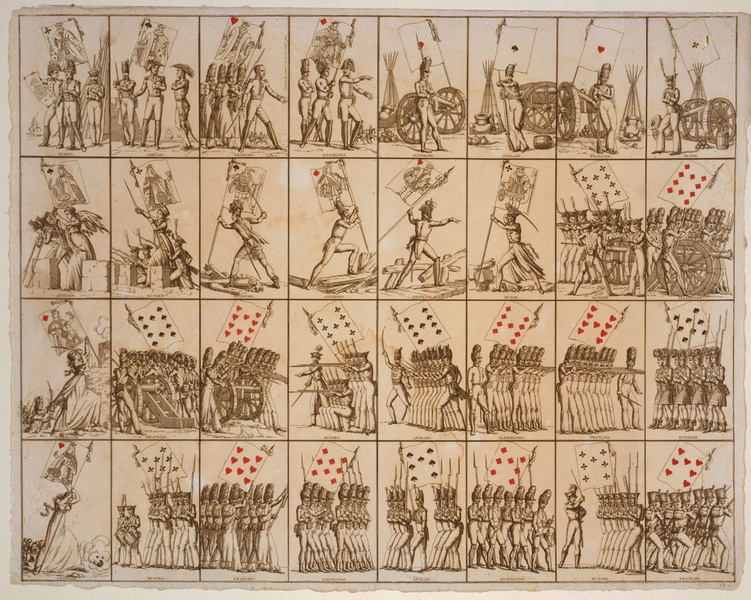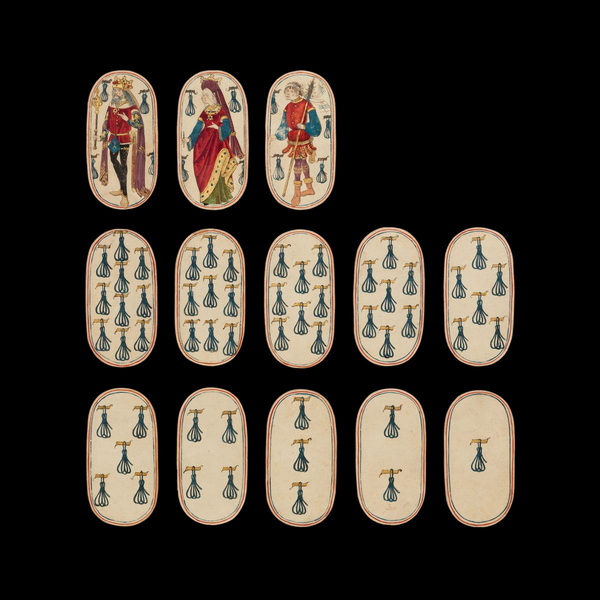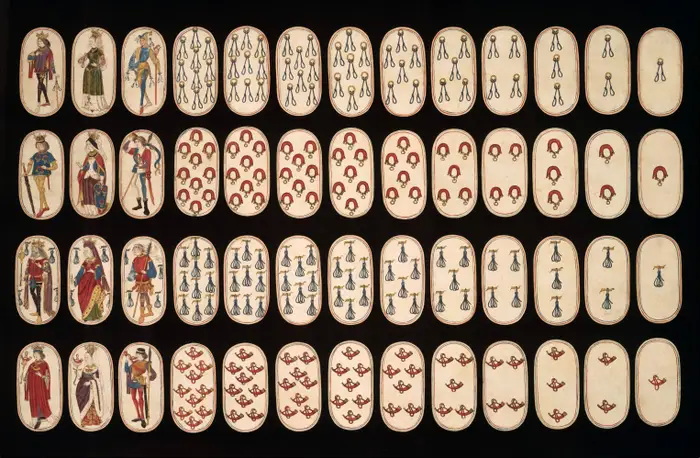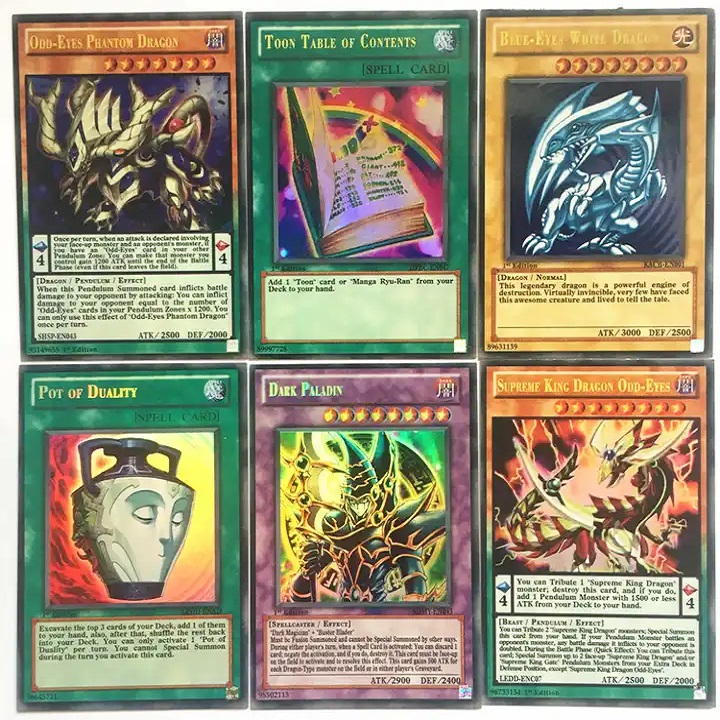Content Menu
● Introduction
>> Early Mentions in Chinese Literature
>> The Significance of Dominoes
>> Madiao: A Notable Early Example
● The Journey Westward: The Spread of Card Games to Europe
>> The Mamluk Influence
>> Early European References
>> The Evolution of Card Designs
● Early European Card Games: Unveiling the Pioneers
>> Karnöffel: A German Contender
>> The Significance of Karnöffel
>> Other Notable Early Games
● The Emergence of Tarot Cards
>> A Unique Evolution
>> Mystical Significance
● Innovations in Card Game Mechanics
>> The Introduction of Trumps
>> The Concept of Bidding
● The 52-Card Deck: A Lasting Legacy
>> Standardization and Symbolism
● Conclusion
● Related Questions
>> 1. What is the oldest complete deck of playing cards?
>> 2. What was the most popular card game in the 1800s?
>> 3. Why are there 52 cards in a deck?
>> 4. Where did playing cards originate?
>> 5. What is the rarest card in a deck?
● Citations:
Introduction
The history of card games is a rich tapestry woven through centuries and across continents, reflecting the diverse cultures and societies that embraced them. Determining the very first card game is a complex endeavor, as early forms of play often lacked detailed documentation. However, by examining historical records, archaeological findings, and linguistic clues, we can piece together a narrative that traces the origins and evolution of these captivating pastimes. This article delves into the earliest known card games, exploring their potential origins, spread, and influence on subsequent games.

The Eastern Roots: China as the Cradle of Card Games
Early Mentions in Chinese Literature
The earliest credible references to games resembling playing cards appear in China during the Tang Dynasty (618–907 AD)[2]. These early forms, sometimes referred to as "leaf games," were documented in various texts, though specific details about their rules and structure remain scarce[3][6]. The term "yezi ge," translating to "game of leaves," is often cited as a potential precursor to modern card games[3][6]. However, it is crucial to note that these early games may have differed significantly from the standardized decks and rulesets we associate with card games today.
The Significance of Dominoes
Adding to the complexity is the historical connection between playing cards and dominoes in Chinese literature[1]. The same word was sometimes used to describe both, suggesting a potential overlap or evolutionary link between the two forms of play. This connection highlights the fluidity of early game formats and the challenges in definitively categorizing them as either card games or other types of recreational activities.
Madiao: A Notable Early Example
Among the early Chinese card games, Madiao stands out as a more concrete example[2]. Emerging during the Tang Dynasty, Madiao decks featured unique designs and served as a foundation for later developments in card game history. These cards, unlike modern decks, often incorporated elements of money and value, indicating their use in gambling and other financial transactions.
The Journey Westward: The Spread of Card Games to Europe
The Mamluk Influence
The introduction of playing cards to Europe is generally attributed to trade routes and cultural exchanges with the Islamic Mamluk dynasty centered in Egypt[1][7]. By the 14th century, cards had made their way into European society, primarily through merchants and travelers[1][2]. These early European cards, like their Mamluk predecessors, were hand-painted, making them luxury items accessible only to the wealthy elite[1].
Early European References
The earliest European mention of playing cards dates back to 1371 in a Catalan language rhyme dictionary, which includes the word "naip" among words ending in "-ip"[7]. This suggests that playing cards were already "reasonably well known" in Catalonia (now part of Spain) at that time[7]. Other early references include a ban on card games in Bern, Switzerland, in 1367, although the validity of this source has been disputed[7]. A Florentine ban in 1377 is generally accepted as the first Italian reference[7].
The Evolution of Card Designs
As playing cards spread across Europe, they underwent significant transformations in design and structure[2]. The suits and symbols evolved, reflecting local cultures and artistic preferences. The Latin suits of swords, batons, cups, and coins were gradually replaced in some regions with the Germanic suits of leaves, hearts, bells, and acorns[3]. These changes marked a crucial step in the evolution of playing cards towards the standardized decks we recognize today.

Early European Card Games: Unveiling the Pioneers
Karnöffel: A German Contender
Among the earliest identifiable European card games, Karnöffel holds a prominent position[3][5]. Originating in Bavaria during the 15th century, Karnöffel is considered the oldest European card game with a continuous tradition of play[3]. The game is named after a specific card, the Karnöffel, which acts as a powerful trump[5].
The Significance of Karnöffel
Karnöffel's historical significance lies in its early adoption of trick-taking mechanics and the use of a specialized deck[2][5]. The game's rules, though not fully preserved, showcase a complex interplay of strategy and chance, setting the stage for later developments in card game design. Karnöffel is considered responsible for many of the tropes that exist in more modern European card games, especially in trick-taking games, most notably being responsible for the general rule that the Ace beats out the King[5].
Other Notable Early Games
Besides Karnöffel, other card games gained popularity in Europe during the 15th century[4]. Gleek, Ronfa, and Condemnade are among the earliest games mentioned by name in historical records[4]. These games, though less documented than Karnöffel, provide valuable insights into the diverse landscape of early European card play.
The Emergence of Tarot Cards
A Unique Evolution
The 15th century also witnessed the emergence of Tarot cards, initially designed for trick-taking games in Italy[2][4]. Unlike standard playing cards, Tarot decks included a separate trump suit with unique pictorial cards. These cards, known as trionfi, added a new layer of complexity and strategy to card games[4].
Mystical Significance
Over time, Tarot cards acquired mystical and divinatory associations[2]. They evolved from mere gaming tools into instruments for fortune-telling and esoteric practices. This transformation highlights the cultural adaptability of playing cards and their capacity to take on diverse symbolic meanings.
Innovations in Card Game Mechanics
The Introduction of Trumps
The arrival of trick-taking games in Europe during the late 14th century marked a significant turning point in card game history[4]. One of the most impactful innovations was the introduction of trump cards, which held the power to defeat all cards in other suits[4]. These trump cards, initially called trionfi, first appeared in Tarot decks[4].
The Concept of Bidding
Another major innovation in card game mechanics was the concept of bidding, which emerged in the 17th century[4]. The Spanish game of Ombre, an evolution of Triomphe, introduced bidding as a means of determining the "Man" who would play alone against the other players[4]. This concept revolutionized card game strategy and paved the way for more complex bidding systems in later games.
The 52-Card Deck: A Lasting Legacy
Standardization and Symbolism
The standardization of the 52-card deck, with its four suits and face cards, represents a pivotal moment in card game history[3]. The deck's structure is often attributed to various symbolic meanings, such as the 52 weeks in a year, the four seasons, and the thirteen lunar cycles[3][6]. Whether these interpretations are historically accurate remains a subject of debate, but they underscore the cultural significance and enduring appeal of the 52-card deck.
Conclusion
Determining the absolute "first" card game is a challenge, as the earliest forms of play were often fluid and undocumented. However, by examining historical records, archaeological evidence, and linguistic clues, we can trace the origins of card games back to China during the Tang Dynasty. These early games, such as the "leaf games" and Madiao, laid the foundation for the spread of card games to Europe and the subsequent evolution of diverse forms of play. Games like Karnöffel stand out as early examples of European card games that have had a lasting influence on modern games. The innovations in card game mechanics, such as the introduction of trumps and bidding, further enriched the landscape of card play. The 52-card deck, with its enduring symbolism and structure, remains a testament to the enduring appeal of card games throughout history.

Related Questions
1. What is the oldest complete deck of playing cards?
The Cloisters set of fifty-two playing cards is currently accepted as the oldest complete deck of playing cards in the world, estimated to be made between 1470 and 1480[3].
2. What was the most popular card game in the 1800s?
Parlor games of all kinds were popular, and a favorite card game in the late 1800s and early 1900s was whist[3][6].
3. Why are there 52 cards in a deck?
The most common theory is that the 52 cards represent 52 weeks in a year. The four colors represent the four seasons. The 13 cards in a suit represent the thirteen weeks in each season[3][6].
4. Where did playing cards originate?
Playing cards were invented by the Chinese before AD1000. They reached Europe around 1360, not directly from China but from the Mameluke empire of Egypt[6][7].
5. What is the rarest card in a deck?
Some of the rarest playing cards in the world include Original Stud Playing Cards, Original Jerry's Nugget Playing Cards, and Brown Wynn Playing Cards[3][6].
Citations:
[1] https://www.britannica.com/topic/playing-card
[2] https://joyful-games.com/blogs/card-and-board-games-101/classic-playing-cards-a-rich-history-and-influence-on-modern-card-games
[3] https://www.gameslearningsociety.org/what-year-was-the-first-card-game-invented/
[4] https://en.wikipedia.org/wiki/Card_game
[5] https://gamerant.com/old-card-games/
[6] https://www.gameslearningsociety.org/where-was-the-first-card-game/
[7] https://en.wikipedia.org/wiki/Playing_card
[8] https://www.parlettgames.uk/histocs/
































